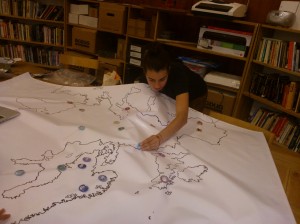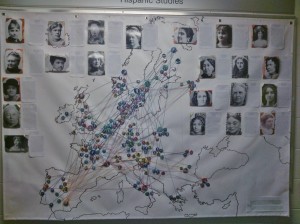1. You never stop learning
I knew very little about women writers in the 19th century before I started the internship. Of course, I had done some research for the interview, but it focused on the project in general. Once we had selected the women writers we wanted to present in a display accompanying the conference, I realised that I had never heard of the women writers from my homeland nor those from my host country. But after compiling biographies and printing out portraits, I think I now know a little about these women’s lives and works, and I hope this will give me the crucial advantage over other competitors in a pub quiz one day.
2. Limit yourself …
When we started this internship, the first few stages evolved around a lot of brainstorming. Which authors should we include in our display? How would we be able to represent the connections between them visually? How many dedications would we have room for in Glasgow Women’s Library? Only one thing was clear from the outset: we had to limit ourselves. After a process of elimination, 22 women writers received a place on the map and a dozen dedications. Since one of the aims of the conference was to recognize the women writers’ achievements, it was no easy business to decide who would feature. But, in order to keep the map clearly laid out and create a visually appealing exhibit, we had no option but to restrict the number
3. … but also dream big
After agreeing on what the exhibit should look like, we had to deal with the practicalities. The map and badges were ordered. I am not sure how many badges we ended up ordering but at least 200 badges. The order consisted of bigger badges, marking the woman writer’s birth country, and smaller badges, locating the woman writer’s reception abroad. Our first step was to pin and stick the badges on the map. I was concerned that it might look too chaotic and messy if we stuck to our original masterplan of connecting the badges with coloured thread. We braced ourselves and went ahead anyway. The final result exceeded our expectations and it not only represented the network of women writers, it was also more appealing than just the badges.
4. Everybody loves a souvenir
On the topic of badges, as I said before, we ordered more of them than needed for the map, so delegates could take “a writer” home as souvenir. The badge design and the bright colours caught people’s attention, and it was a great way of introducing little known women writers to a large audience. Delegates wanted to know who was who and where the women writers were from. Speakers chose their favourite and pinned it to their clothing. Italian author, Matilde Serao was just one of the writers in high demand, and by the end of the conference our stock of badges had dwindled to none.
5. Reward of exchanging ideas
Meeting up in person to talk about ideas and discuss further plans is the most effective way to make progress. This can relate to a small group, like our group of interns or to a bigger group such as delegates taking part in a conference. Talking about ideas, listening to ideas, developing ideas further or completely scrapping certain ideas are all part of coming to a satisfying conclusion. We interns would often meet up to discuss the display and then present our ideas to Henriette and Judith to ask for feedback. Teamwork was not only indispensable for the development and implementation of our ideas, it was also an incredibly fulfilling experience working alongside others to make a contribution to the conference.

